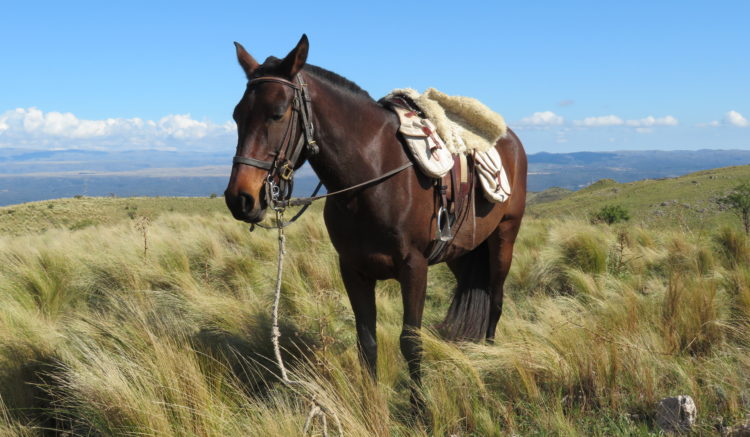For a truly authentic Argentine experience, we booked a four-night stay at an estancia to immerse ourselves in the gaucho and ranching lifestyle. Our destination was Estancia Los Potreros, located 55 kilometres outside Córdoba, nestled in the foothills of the Sierras Chicas. The estancia has been run by the Anglo-Argentinian Begg family for generations, with our hosts, Kevin and Louise, welcoming guests to share in this unique way of life since the early 2000s.





Geography and Climate
The Sierras Chicas are characterised by their rugged, undulating terrain, which contrasts with the vast flat plains of the Pampas to the south. This hill country offers breathtaking views of rolling hills, rocky outcrops, and sprawling pastures, perfect for cattle and horse breeding. The region enjoys a temperate climate, with hot summers and cooler winters, and tends to be drier than the lowland Pampas. The hills are dotted with native vegetation, including low shrubs and grasses, while the surrounding forests are home to a variety of wildlife.
Estancia Life and Ranch Animals
Estancia Los Potreros spans hundreds of hectares of hilly terrain, offering a perfect backdrop for both cattle ranching and horse breeding. The ranch has around 150 horses, primarily Peruvian Paso and Criollo breeds. The Peruvian Paso, with its smooth gait, is ideal for long rides across the estancia, while the Criollo horses, native to Argentina, are renowned for their endurance and ability to handle rugged landscapes. Both breeds are integral to the traditional gaucho lifestyle, used for herding cattle, working the land, and even playing polo.
In addition to the horses, the estancia is home to a large herd of organically managed black Aberdeen Angus cattle. These cattle are bred on the estancia, but after their early growth, they are sent to the richer Pampas plains to fatten up on the nutritious grasses. This dual-location management system ensures the best quality beef, which Argentina is famous for.


| The Story of Aberdeen Angus Cattle in Argentina The introduction of Aberdeen Angus cattle to Argentina can be traced back to the late 19th century, when Scottish settlers and British livestock breeders brought the first animals from Scotland. The Aberdeen Angus breed, originally from the northeastern counties of Aberdeenshire and Angus in Scotland, quickly adapted to Argentina’s vast Pampas region. These cattle were highly valued for their ability to thrive in the country’s varying climates and for the quality of their beef. What makes Aberdeen Angus cattle so special is their natural resilience and adaptability. They are a hardy breed, able to withstand harsh weather conditions, and they mature relatively early compared to other breeds, producing high-quality, well-marbled beef that is prized worldwide. Their meat is tender, with a distinct rich flavour, making Aberdeen Angus one of the most sought-after breeds in the beef industry. Today, Argentina has one of the largest populations of Aberdeen Angus cattle outside of Scotland, and the breed has become central to the country’s world-renowned beef production. |
A Taste of Gaucho Life
Horse riding forms the heart of the estancia’s daily activities, and we had the opportunity to explore the beautiful countryside twice daily, with both morning and afternoon rides. Each ride was accompanied by local gauchos and experienced guides, who tailored the rides to suit all skill levels, whether novice riders like us or seasoned equestrians.
The gauchos are the true custodians of Argentina’s rural heritage. Dressed in their distinctive bombachas (loose trousers) and wide-brimmed hats, they are experts in horsemanship and cattle management. We even got to assist in rounding up foals, an essential task to protect them from pumas, which still roam the hills. The local fauna also includes the mighty Andean condor, whose vast wingspan can be seen gliding effortlessly above the estancia, feeding on carrion such as fallen cattle.



Exploring the Surroundings
The estancia’s hill country offered stunning scenery, particularly from the hilltops, where we were rewarded with panoramic views of the Sierras Chicas. One of the highlights was a visit to the “bell rock,” an unusual geological formation that, when struck, emits a bell-like sound. The exact cause of this phenomenon remains a mystery, though some speculate it could be linked to ancient geological forces, lightning strikes, or even the distant cultures of South America.
Polo – The Gaucho’s Game
On our final day, we were treated to a taste of Argentina’s national sport – polo. Though none of us were seasoned players, we were given a crash course in the basics before participating in a friendly game with fellow guests, guides, and gauchos. Polo is deeply intertwined with Argentine culture, and the Criollo horses, perfectly suited for the sport, made the experience all the more thrilling.




Dining at the Estancia
The estancia experience also extended to the dining table, where Kevin and Louise hosted intimate family-style dinners in the main lodge. Meals featured locally sourced, organic produce, including beef from the estancia’s own cattle, paired with fine Argentine wines. The traditional décor, including early photographs of life on the estancia, added to the sense of stepping back in time, offering guests a glimpse of the region’s rich history.
Dates: 19/04/2018 to 24/04/2018
